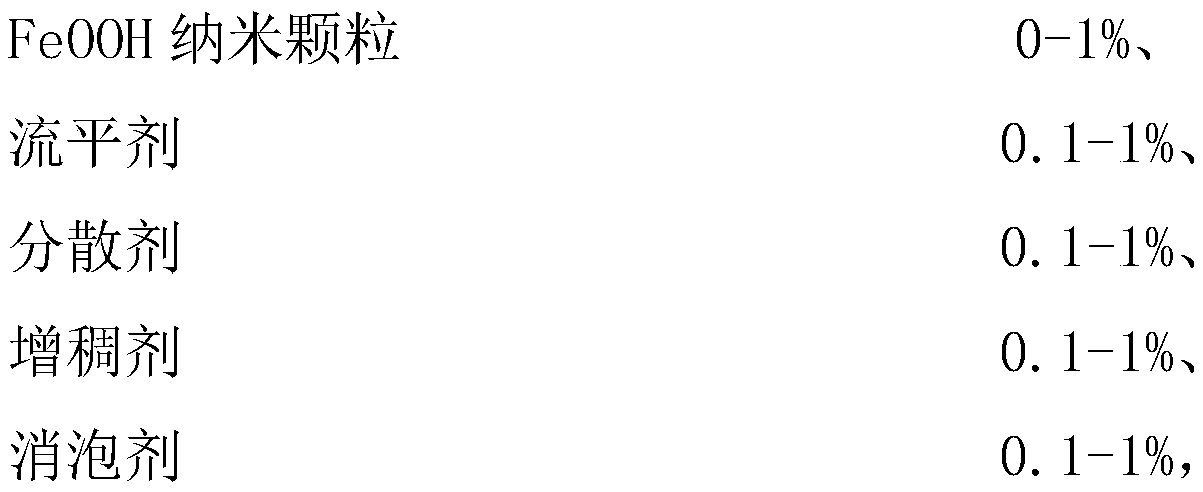Visible photocatalysis functional topcoat with quantum dots and preparation method of visible photocatalysis functional topcoat
A photocatalytic and visible light technology, applied in the field of coatings, can solve the problems of visible light responsiveness, weak light absorption ability, and weakened life of photosensitive dyes, etc., to improve photocatalytic reactivity, uniform and stable coating performance, and enhance photodecomposition effect of ability
- Summary
- Abstract
- Description
- Claims
- Application Information
AI Technical Summary
Problems solved by technology
Method used
Image
Examples
Embodiment 1
[0029] A visible light photocatalytic functional surface coating containing quantum dots, comprising the following components by weight percentage:
[0030] Silicate paint resin 5%,
[0031] 2-10nm Au ion-doped titanium dioxide quantum dots 5%,
[0032] Silicon nanoparticles with particle size less than 8nm 0.5%,
[0033] Carboxymethylcellulose leveling agent 0.2%,
[0034] Organic phosphonic acid scale inhibitor dispersant 0.2%,
[0035] Non-ionic polyurethane associative thickener 0.2%,
[0036] Silica derivative defoamer 0.2%,
[0037] The balance is water.
[0038] The preparation method is as follows:
[0039] a) adding silicon nanoparticles into water for activation and stirring for later use; adding titanium dioxide quantum dots doped with noble metal ions, and ball milling with a ball mill for 0.25-1 hour at a speed of 70-1500 rpm until uniform to form a suspension;
[0040]b) Add silicate paint resin to the suspension obtained in step a), and use a ball mill to...
Embodiment 2
[0042] The formula and preparation method in this example are similar to Example 1, the only difference is that instead of using silicon nanoparticles with a particle size of less than 8nm in this example, silicon nanoparticles with a particle size of 20-200nm are used, All the other are identical with embodiment 1.
Embodiment 3
[0044] A visible light photocatalytic functional surface coating containing quantum dots, comprising the following components by weight percentage:
[0045] Silicate paint resin 5%,
[0046] 2-10nm Au ion-doped titanium dioxide quantum dots 5%,
[0047] Silicon nanoparticles with particle size less than 8nm 0.5%,
[0048] FeOOH nanoparticles with particle size less than 20nm 0.6%,
[0049] Carboxymethylcellulose leveling agent 0.2%,
[0050] Organic phosphonic acid scale inhibitor dispersant 0.2%,
[0051] Non-ionic polyurethane associative thickener 0.2%,
[0052] Silica derivative defoamer 0.2%,
[0053] The balance is water.
[0054] The preparation method is as follows:
[0055] a) Add silicon nanoparticles into water to activate and stir for later use; add noble metal ion-doped titanium dioxide quantum dots and FeOOH nanoparticles, and use a ball mill at a speed of 70-1500 rpm for 0.25-1 hour to form a suspension liquid;
[0056] b) Add silicate paint resin to th...
PUM
| Property | Measurement | Unit |
|---|---|---|
| particle diameter | aaaaa | aaaaa |
| particle diameter | aaaaa | aaaaa |
| particle diameter | aaaaa | aaaaa |
Abstract
Description
Claims
Application Information
 Login to View More
Login to View More - R&D
- Intellectual Property
- Life Sciences
- Materials
- Tech Scout
- Unparalleled Data Quality
- Higher Quality Content
- 60% Fewer Hallucinations
Browse by: Latest US Patents, China's latest patents, Technical Efficacy Thesaurus, Application Domain, Technology Topic, Popular Technical Reports.
© 2025 PatSnap. All rights reserved.Legal|Privacy policy|Modern Slavery Act Transparency Statement|Sitemap|About US| Contact US: help@patsnap.com


